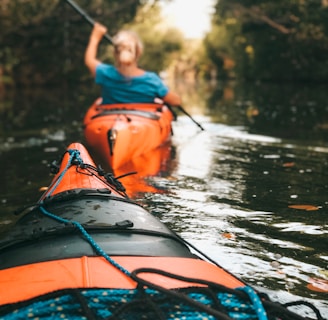The Many Benefits of Canoeing or Kayaking: Exploring Nature's Playground
Are you looking for a fun and adventurous way to connect with nature? Look no further than the exhilarating world of canoeing and kayaking. Whether you're a beginner or an experienced paddler, these water sports offer a wide range of benefits that go beyond just having a good time. In this article, we'll dive into the many physical, mental, and social advantages of canoeing and kayaking, as well as some tips for getting started.
12/12/20233 min read


The Many Benefits of Canoeing or Kayaking: Exploring Nature's Playground
Are you looking for a fun and adventurous way to connect with nature? Look no further than the exhilarating world of canoeing and kayaking. Whether you're a beginner or an experienced paddler, these water sports offer a wide range of benefits that go beyond just having a good time. In this article, we'll dive into the many physical, mental, and social advantages of canoeing and kayaking, as well as some tips for getting started.
The Physical Benefits
Canoeing and kayaking are excellent forms of exercise that engage various muscle groups throughout your body. The repetitive motion of paddling helps to strengthen your arms, shoulders, and back, while also toning your core and legs. It's a low-impact activity that puts minimal stress on your joints, making it suitable for people of all ages and fitness levels.
Spending time on the water also provides a unique cardiovascular workout. As you paddle against the resistance of the water, your heart rate increases, improving your overall cardiovascular health. It's a great way to burn calories and maintain a healthy weight.
Furthermore, being out in nature offers additional physical benefits. The fresh air and sunlight provide a natural boost to your immune system, while the peaceful surroundings help to reduce stress levels. The tranquility of gliding through calm waters can have a soothing effect on your mind and body.
The Mental Benefits
Canoeing and kayaking are not only good for your body but also for your mind. Spending time in nature has been proven to reduce anxiety and improve mental well-being. The rhythmic motion of paddling can have a meditative effect, allowing you to clear your mind and find inner peace.
Exploring new waterways and encountering wildlife along the way can be a thrilling and educational experience. It stimulates your senses and enhances your awareness of the natural world. The sense of accomplishment that comes from navigating through challenging currents or reaching a remote destination can boost your self-confidence and improve your overall mood.
Moreover, canoeing and kayaking often require problem-solving skills and decision-making. You'll need to navigate through obstacles, read the water, and adjust your paddling technique accordingly. These mental challenges help to keep your mind sharp and improve your cognitive abilities.
The Social Benefits
Canoeing and kayaking can also be a fantastic social activity. Whether you go solo or paddle with a group of friends or family, it provides an opportunity to connect and bond with others. Exploring new waters together, sharing experiences, and overcoming challenges can create lasting memories and strengthen relationships.
Joining a local paddling club or participating in organized events and races can introduce you to a vibrant community of like-minded individuals. You can learn from experienced paddlers, exchange tips and stories, and make new friends who share your passion for the water.
Additionally, canoeing and kayaking can be a family-friendly activity. It's a great way to spend quality time with your loved ones, away from the distractions of daily life. Children can learn valuable life skills such as teamwork, communication, and resilience, while also developing a love and respect for nature.
Getting Started
If you're ready to embark on your canoeing or kayaking adventure, here are a few tips to help you get started:
Choose the right equipment: Invest in a quality canoe or kayak that suits your needs and skill level. Don't forget essential safety gear such as a life jacket, helmet, and whistle.
Take lessons: If you're new to paddling, consider taking lessons from a certified instructor. They can teach you proper paddling techniques, safety protocols, and help build your confidence on the water.
Start slow: Begin with calm and shallow waters to practice your paddling skills. As you gain experience and confidence, you can gradually explore more challenging environments.
Plan your trips: Research and plan your paddling trips in advance. Check weather conditions, water levels, and any potential hazards. Let someone know your itinerary and expected return time.
Respect nature: Always follow the principles of Leave No Trace. Minimize your impact on the environment, respect wildlife, and pack out any trash.
Remember, safety should always be your top priority. Be aware of your limitations, stay hydrated, and never underestimate the power of water. By following these guidelines, you'll be well-prepared to enjoy the many benefits of canoeing and kayaking.
So, what are you waiting for? Grab a paddle, hop in a canoe or kayak, and let nature be your playground!
Disclaimer: The images used in this article are for illustrative purposes only and do not necessarily depict the specific activities mentioned.
Contacts
Socials
Subscribe to our newsletter
(888) 719-1073
Copyright © Traveltobe.net 2019. All rights reserved
